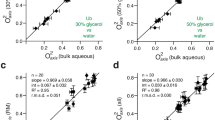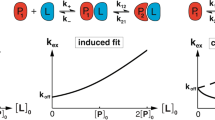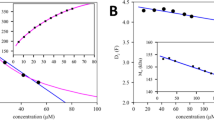Abstract
Molecular recognition by proteins is fundamental to almost every biological process, particularly the protein associations underlying cellular signal transduction. Understanding the basis for protein–protein interactions requires the full characterization of the thermodynamics of their association. Historically it has been virtually impossible to experimentally estimate changes in protein conformational entropy, a potentially important component of the free energy of protein association. However, nuclear magnetic resonance spectroscopy has emerged as a powerful tool for characterizing the dynamics of proteins. Here we employ changes in conformational dynamics as a proxy for corresponding changes in conformational entropy. We find that the change in internal dynamics of the protein calmodulin varies significantly on binding a variety of target domains. Surprisingly, the apparent change in the corresponding conformational entropy is linearly related to the change in the overall binding entropy. This indicates that changes in protein conformational entropy can contribute significantly to the free energy of protein–ligand association.
This is a preview of subscription content, access via your institution
Access options
Subscribe to this journal
Receive 51 print issues and online access
$199.00 per year
only $3.90 per issue
Buy this article
- Purchase on Springer Link
- Instant access to full article PDF
Prices may be subject to local taxes which are calculated during checkout



Similar content being viewed by others
References
Wodak, S. J. & Janin, J. Structural basis of macromolecular recognition. Adv. Prot. Chem. 61, 9–73 (2002)
Clackson, T. & Wells, J. A. A hot spot of binding energy in a hormone-receptor interface. Science 267, 383–386 (1995)
Spolar, R. S. & Record, M. T. Coupling of local folding to site-specific binding of proteins to DNA. Science 263, 777–784 (1994)
Sturtevant, J. M. Heat capacity and entropy changes in processes involving proteins. Proc. Natl Acad. Sci. USA 74, 2236–2240 (1977)
Steinberg, I. Z. & Scheraga, H. A. Entropy changes accompanying association reactions of proteins. J. Biol. Chem. 238, 172–181 (1963)
Cooper, A. & Dryden, D. T. F. Allostery without conformational change — a plausible model. Eur. Biophys. J. Biophys. Lett. 11, 103–109 (1984)
Karplus, M., Ichiye, T. & Pettitt, B. M. Configurational entropy of native proteins. Biophys. J. 52, 1083–1085 (1987)
Grunberg, R., Nilges, M. & Leckner, J. Flexibility and conformational entropy in protein–protein binding. Structure 14, 683–693 (2006)
Igumenova, T. I., Frederick, K. K. & Wand, A. J. Characterization of the fast dynamics of protein amino acid side chains using NMR relaxation in solution. Chem. Rev. 106, 1672–1699 (2006)
Cavanagh, J. et al. Protein NMR spectroscopy: Principles and practice 2nd edn (Elsevier, Burlington, Massachusetts, 2006)
Kahl, C. R. & Means, A. R. Regulation of cell cycle progression by calcium/calmodulin-dependent pathways. Endocr. Rev. 24, 719–736 (2003)
Yap, K. L. et al. Calmodulin target database. J. Struct. Funct. Genom. 1, 8–14 (2000)
Lee, A. L., Kinnear, S. A. & Wand, A. J. Redistribution and loss of side chain entropy upon formation of a calmodulin-peptide complex. Nature Struct. Biol. 7, 72–77 (2000)
Lukas, T. J. et al. Calmodulin binding domains: characterization of a phosphorylation and calmodulin binding site from myosin light chain kinase. Biochemistry 25, 1458–1464 (1986)
Zhang, M. & Vogel, H. J. Characterization of the calmodulin-binding domain of rat cerebellar nitric oxide synthase. J. Biol. Chem. 269, 981–985 (1994)
Tokumitsu, H. et al. Calcium/calmodulin-dependent protein kinase kinase: identification of regulatory domains. Biochemistry 36, 12823–12827 (1997)
Goldberg, J., Nairn, A. C. & Kuriyan, J. Structural basis for the autoinhibition of calcium/calmodulin-dependent protein kinase I. Cell 84, 875–887 (1996)
Charbonneau, H. et al. Evidence for domain organization within the 61-kDa calmodulin-dependent cyclic nucleotide phosphodiesterase from bovine brain. Biochemistry 30, 7931–7940 (1991)
Wintrode, P. L. & Privalov, P. L. Energetics of target peptide recognition by calmodulin: a calorimetric study. J. Mol. Biol. 266, 1050–1062 (1997)
Brokx, R. D. et al. Energetics of target peptide binding by calmodulin reveals different modes of binding. J. Biol. Chem. 276, 14083–14091 (2001)
Farrow, N. A. et al. Backbone dynamics of a free and a phosphopeptide-complexed Src homology-2 domain studied by 15N NMR relaxation. Biochemistry 33, 5984–6003 (1994)
Wang, T., Cai, S. & Zuiderweg, E. R. Temperature dependence of anisotropic protein backbone dynamics. J. Am. Chem. Soc. 125, 8639–8643 (2003)
Muhandiram, D. R. et al. Measurement of H-2 T-1 and T-1p relaxation-times in uniformly C-13-Labeled and fractionally H-2-labeled proteins in solution. J. Am. Chem. Soc. 117, 11536–11544 (1995)
Akke, M., Bruschweiler, R. & Palmer, A. G. NMR order parameters and free-energy — an analytical approach and its application to cooperative Ca2+ binding by calbindin-D(9k). J. Am. Chem. Soc. 115, 9832–9833 (1993)
Li, Z., Raychaudhuri, S. & Wand, A. J. Insights into the local residual entropy of proteins provided by NMR relaxation. Prot. Sci. 5, 2647–2650 (1996)
Lee, A. L. et al. Temperature dependence of the internal dynamics of a calmodulin-peptide complex. Biochemistry 41, 13814–13825 (2002)
Lee, A. L. & Wand, A. J. Microscopic origins of entropy, heat capacity and the glass transition in proteins. Nature 411, 501–504 (2001)
Best, R. B., Clarke, J. & Karplus, M. The origin of protein sidechain order parameter distributions. J. Am. Chem. Soc. 126, 7734–7735 (2004)
Chou, J. J., Case, D. A. & Bax, A. Insights into the mobility of methyl-bearing side chains in proteins from 3JCC and 3JCN couplings. J. Am. Chem. Soc. 125, 8959–8966 (2003)
Best, R. B., Clarke, J. & Karplus, M. What contributions to protein side-chain dynamics are probed by NMR experiments? A molecular dynamics simulation analysis. J. Mol. Biol. 349, 185–203 (2005)
Kranz, J. K. et al. A direct test of the reductionist approach to structural studies of calmodulin activity: relevance of peptide models of target proteins. J. Biol. Chem. 277, 16351–16354 (2002)
Lipari, G. & Szabo, A. Model-free approach to the interpretation of nuclear magnetic-resonance relaxation in macromolecules. 1. Theory and range of validity. J. Am. Chem. Soc. 104, 4546–4559 (1982)
Dellwo, M. J. & Wand, A. J. Model-independent and model-dependent analysis of the global and internal dynamics of cyclosporine-A. J. Am. Chem. Soc. 111, 4571–4578 (1989)
Scott, D. On optimal and data-based histograms. Biometrika 10, 605–610 (1979)
Acknowledgements
This work was supported by a grant from the National Institutes of Health. We are grateful to S. W. Englander for helpful discussion and to Mark I. Greene for access to isothermal titration calorimetry instrumentation.
Author Contributions A.J.W. devised and initiated the project. K.K.F., M.S.M., and K.G.V. prepared the materials, collected and analysed the primary data. K.K.F. and A.J.W. performed the entropy analysis. A.J.W. wrote the manuscript.
Author information
Authors and Affiliations
Corresponding author
Ethics declarations
Competing interests
Reprints and permissions information is available at www.nature.com/reprints. The authors declare no competing financial interests.
Supplementary information
Supplementary Information
This file contains Supplementary Figure S1 with Legend and Supplementary Tables S1-S7. (PDF 304 kb)
Rights and permissions
About this article
Cite this article
Frederick, K., Marlow, M., Valentine, K. et al. Conformational entropy in molecular recognition by proteins. Nature 448, 325–329 (2007). https://doi.org/10.1038/nature05959
Received:
Accepted:
Issue Date:
DOI: https://doi.org/10.1038/nature05959
This article is cited by
-
Role of Conformational Entropy in Complex Macromolecular Systems
Chemical Research in Chinese Universities (2023)
-
Conformational flexibility of a free and TCR-bound pMHC-I protein investigated by long-term molecular dynamics simulations
BMC Immunology (2022)
-
GEOM, energy-annotated molecular conformations for property prediction and molecular generation
Scientific Data (2022)
-
Emerging functional materials based on chemically designed molecular recognition
BMC Materials (2020)
-
Protein conformational entropy is not slaved to water
Scientific Reports (2020)
Comments
By submitting a comment you agree to abide by our Terms and Community Guidelines. If you find something abusive or that does not comply with our terms or guidelines please flag it as inappropriate.



